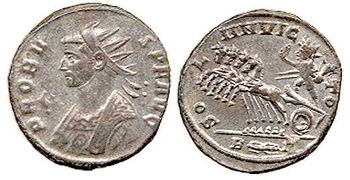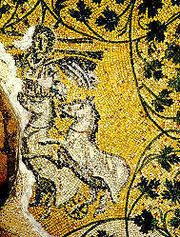Sol Invictus ("the undefeated Sun") or, more fully, Deus Sol Invictus ("the undefeated sun god") was a religious title applied to at least three distinct divinities during the later Roman Empire; El Gabal, Mithras, and Sol.
Unlike the earlier, agrarian cult of Sol Indiges ("the native sun" or "the invoked sun" - the etymology and meaning of the word "indiges" is disputed), the title Deus Sol Invictus was formed by analogy with the imperial titulature pius felix invictus ("dutiful, fortunate, unconquered").
A festival of the birth of the Unconquered Sun (or Dies Natalis Solis Invicti) was celebrated when the duration of daylight first begins to increase after the winter solstice,—the "rebirth" of the sun.
Contents |
Elagabalus of Sol Invictus
The title first gained prominence under the emperor Elagabalus, who abortively attempted to impose the worship of El Gabal, the sun-god of his native city Emesa in Syria. With the emperor's death in 222, however, this religion ceased, though emperors continued to be portrayed on coinage with the radiant sun-crown, for close to a century.
In the second instance, the title invictus was applied to Mithras in private inscriptions by devotees. It also appears applied to Mars.
Aurelian of Sol Invictus
The Roman gens Aurelia was associated with the cult of Sol. After his victories in the East, the emperor Aurelian introduced an official cult of Sol Invictus, making the sun-god the premier divinity of the empire, and wearing his radiated crown himself. He founded a college of pontifices, and dedicated a temple to Sol Invictus in 274. It is possible that he created the festival called dies natalis Solis Invicti, "birthday of the undefeated Sun", which is recorded in 354 as celebrated on the 25th December; but no earlier reference to it exists.
Constantine of Sol Invictus
Emperors up to Constantine portrayed Sol Invictus on their official coinage, with the legend SOLI INVICTO COMITI, thus claiming the Unconquered Sun as a companion to the Emperor. During the reign of Constantine the coinage ceases to be pagan in 325, and Sol Invictus disappears with the rest at that date.
Constantine decreed (March 7, 321) dies Solis
- On the venerable day of the Sun let the magistrates and people residing in cities rest, and let all workshops be closed. In the country however persons engaged in agriculture may freely and lawfully continue their pursuits because it often happens that another day is not suitable for grain-sowing or vine planting; lest by neglecting the proper moment for such operations the bounty of heaven should be lost..
The religion of Sol Invictus continued to be part of the state religion until paganism was abolished by the decree of Theodosius I decree on February 27, 390.
Christianity adopted some of the attributes of the Sol Invictus religion, as apparent in the first examples of Christian iconography, depicting Jesus Christ with solar attributes such as the radiated crown or, in a few instances, a solar chariot..
Sol Invictus had been adopted by the Church of Rome, as evidenced by Christ depicted as Apollo-Helios in a mausoleum discovered under St. Peter's Basilica and dated to 250[1], and, from the beginning of the third century, "Sun of Justice" was used as a title of Christ[2].
The date for Christmas may also bear a relation to the sun worship. According to the Syriac bishop Jacob Bar-Salibi, writing in the twelth century:
- "It was a custom of the Pagans to celebrate on the same 25 December the birthday of the Sun, at which they kindled lights in token of festivity. In these solemnities and revelries the Christians also took part. Accordingly when the doctors of the Church perceived that the Christians had a leaning to this festival, they took counsel and resolved that the true Nativity should be solemnised on that day." (cited in "Christianity and Paganism in the Fourth to Eighth Centuries", Ramsay MacMullen. Yale:1997, p155)
Catholic Encyclopedia: Christmas states: "The well-known solar feast, however, of Natalis Invicti, celebrated on 25 December, has a strong claim on the responsibility for our December date."
Christianity designated Sunday as the "Lord's Day" and the day of rest, rather than Saturday, the Jewish Sabbath. See also Constantine I and Christianity..
External links
- Encyclopedia Britannica Online: Sol
- Probus and Sol, includes images of coins
- Roman-Emperors: Aurelian
- Gibbon's Decline and Fall: Triumph of Aurelian
- Gibbon's references for Aurelian's Temple of Sol Invictus
- Clement A. Miles, Christmas in Ritual and Tradition, Christian and Pagan (1912): December 25 and the Natalis Invicti
- Catholic Encyclopedia: Christmass
- Ancient sources
Notes
- ^ New Catholic Encyclopedia, "Constantine the Great", 1967.
- ^ New Catholic Encyclopedia, "Christmas".
- ^ "Constantine the Great" , New Catholic Encyclopedia, 1967
- ^ ibid., "Christmas"
Categories: Christmas-linked holidays




